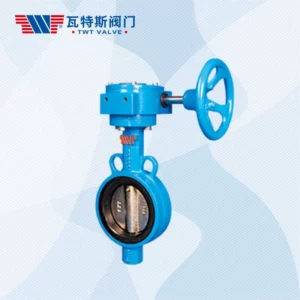Butterfly valves are a type of quarter-turn valve that are commonly used in industrial applications. They are named for their shape, which resembles a butterfly with wings spread. Butterfly valves are used to regulate the flow of fluids, such as water, air, gas, and slurries, by rotating a disc or vane inside the valve body.
Butterfly valves offer several advantages over other types of valves, including their lightweight and compact design, low pressure drop, and quick and easy operation. They are often more cost-effective than other types of valves, making them a popular choice for applications where cost is a primary consideration.
Butterfly valves are used in a variety of industrial applications, including:
Water treatment: Butterfly valves are commonly used in water treatment plants to control the flow of water through pipes and valves.
HVAC systems: Butterfly valves are used in heating, ventilation, and air conditioning (HVAC) systems to regulate the flow of air.
Food and beverage processing: Butterfly valves are used in food and beverage processing to control the flow of liquids and gases.
Chemical processing: Butterfly valves are used in chemical processing to control the flow of corrosive or hazardous materials.
Power generation: Butterfly valves are used in power generation plants to control the flow of steam and water.
Oil and gas: Butterfly valves are used in the oil and gas industry to control the flow of fluids in pipelines and storage tanks.
Overall, butterfly valves are a versatile and cost-effective choice for a wide range of industrial applications. wafer butterfly valve They offer reliable flow control and are easy to operate and maintain.
What are some common materials used to make butterfly valves, and how do they affect their performance?
Butterfly valves can be made from a variety of materials, and the choice of material can have a significant impact on their performance.
Some common materials used to make butterfly valves include:
Cast iron: Cast iron butterfly valves are durable and offer good corrosion resistance. They are often used in industrial applications where high strength and durability are required.
Stainless steel: Stainless steel butterfly valves offer excellent corrosion resistance and are often used in applications where the valve will be exposed to corrosive fluids or environments.
PVC: PVC butterfly valves are lightweight and have good chemical resistance. They are often used in water treatment and wastewater applications.
Bronze: Bronze butterfly valves offer good corrosion resistance and are often used in marine and saltwater applications.
Aluminum: Aluminum butterfly valves are lightweight and have good corrosion resistance. They are often used in HVAC and air handling applications.
The choice of material can affect the performance of butterfly valves in several ways, including their ability to resist corrosion, withstand high temperatures and pressures, and maintain a tight seal. For example, if the valve will be exposed to corrosive fluids or environments, a material with good corrosion resistance, such as stainless steel or bronze, may be a better choice. Similarly, if the valve will be used in high-temperature applications, a material with good heat resistance, such as cast iron, may be a better choice. It’s important to choose the appropriate material for the specific application to ensure optimal performance and longevity of the valve.
